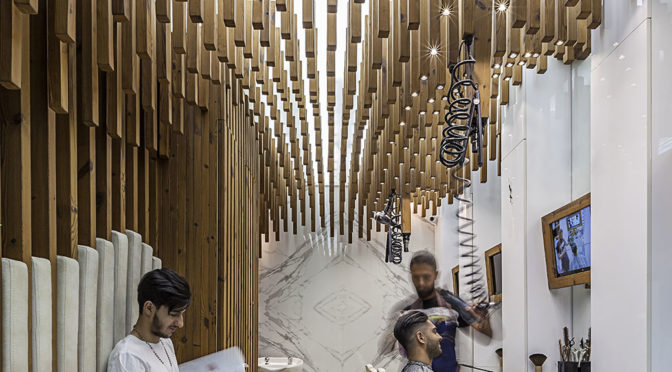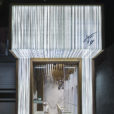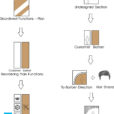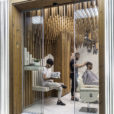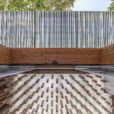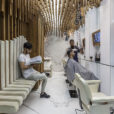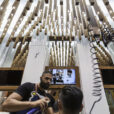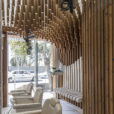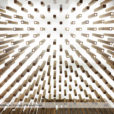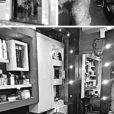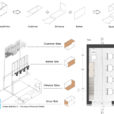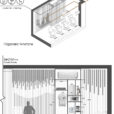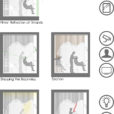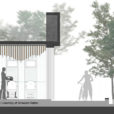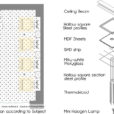پیرایشگاه تولا
فرنوش رافعی
موقعیت: اصفهان، ایران
تاریخ: ۱۳۹۶
مساحت: ۱۲/۵ مترمربع
وضعیت: ساختهشده
کارفرما: محمد تولا
عکس: نگار صدیقی
کارفرمای پروژه به منظور رفع مشکلات عملکردی پیرایشگاه خود و استفاده بهینهتر از فضای محدود کار، برای بازسازی به دفتر ما مراجعه کرد. پروژه در دو مقیاس فضای داخلی و فضای شهری (بدنه خیابان)، با چالش روبرو بود و میبایست برای حل مشکلات آن در هر دو مقیاس چارهای اندیشید.
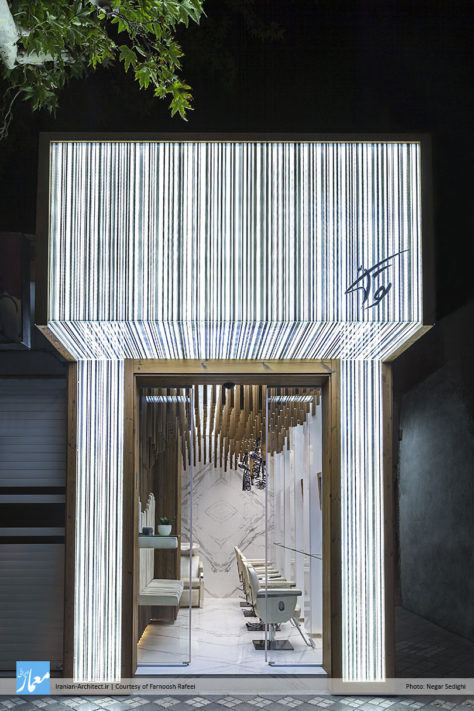
در مقیاس داخلی، از یکسو با محدودیت فضای مغازه (۲/۵ در ۵ متر)، و از سوی دیگر، با خواست کارفرما مبنی بر استفاده حداکثری از مساحت موجود روبرو بودیم. از اینرو، برای پرهیز از شلوغی و تداخل عرصهها و عملکردها که تهدید بالقوه پروژه محسوب میشد، ابتدا به معنای خود واژه «پیرایش» که همان کاستن اضافات و ساماندهی وضع موجود است، رجوع کردیم. در همین راستا، با شناخت زمینه طراحی و الگوهای رفتاری موجود، به تفکیک مشخص هر یک از عملکردها پرداختیم و سعی شد معماری فضا در هر قسمت متناسب با این عملکردها شکل داده شود. در واقع، در یک نگاه کلی، بستر پیرایشگاه به دو عرصه مشتری (مهمان) و پیرایشگر (میزبان) تقسیم شد و سپس با توجه به سلسله مراتب استفاده از محیط توسط مشتری، این عرصهها به بخشهای ریزتر انتظار، خدمات، آمادهسازی و شستشو تقسیم و سازماندهی شدند تا الگوی رفتاری کاربر با نقشه رفتاری آن در پلان مطابقت کند.
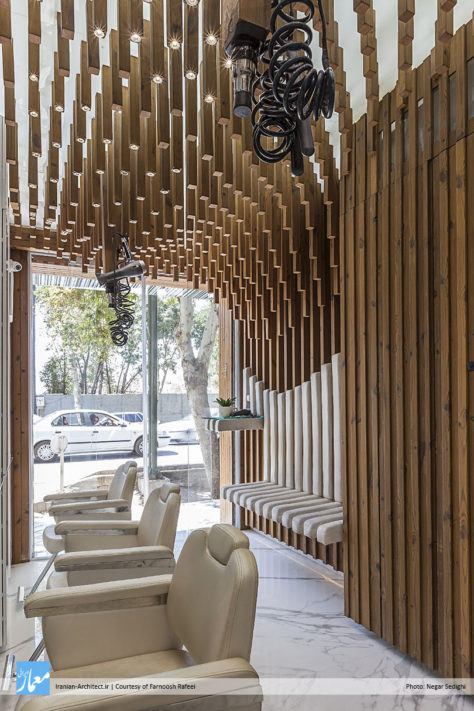
از لحاظ فرمی، تارهای مو به عنوان کلیدواژهای که سوژه اصلی پیرایش است، دستاویزی شد تا به مثابه نخ تسبیح، کلیه اتفاقات و عملکردها را به یکدیگر پیوند دهد و فضایی آراسته و یکپارچه را رقم بزند. ترجمه معمارانه این تارهای مو، در نهایت به صورت یک حرکت نرم و موجیشکلِ مجموعهای از مدولهای چوبی (فرم انتزاعی تارهای مو بر روی سر) درآمد که روی سقف، گسترده و تا جداره کشیده و در امتداد نما به خطوطی آراسته تبدیل میشوند.
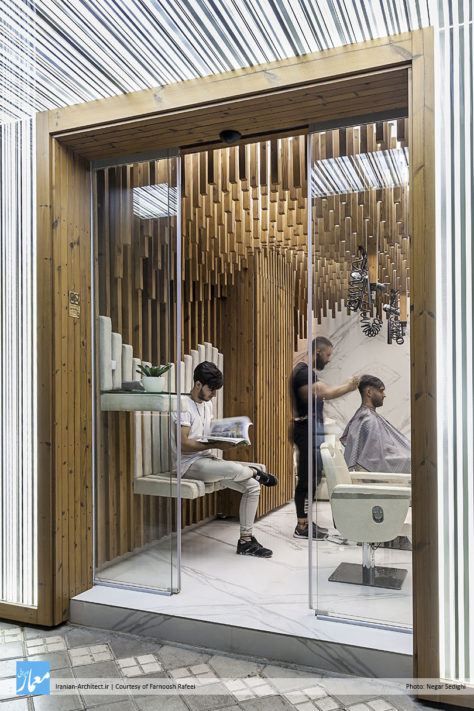
در مقیاس شهری، از آنجا که پیرایشگاه در خیابان میر اصفهان با تعدد دیگر همصنفان رقیب روبرو بود، کارفرما میخواست که هر چه بیشتر مغازه خود را «خوانا» سازد تا هم بتواند در میان رقبا بیشتر جلب توجه کند و هم بخشی از مهارت و اتفاقات داخل را در بیرون به معرض نمایش بگذارد. پس سعی شد اتفاقات و ایدههای داخلی از لحاظ کالبدی و بصری، به طریقی راه خود را به سمت بیرون و نما باز کنند تا ضمن حفظ یکپارچگی فضا، دعوتکننده و در عین حال برای مخاطب جذاب باشند.
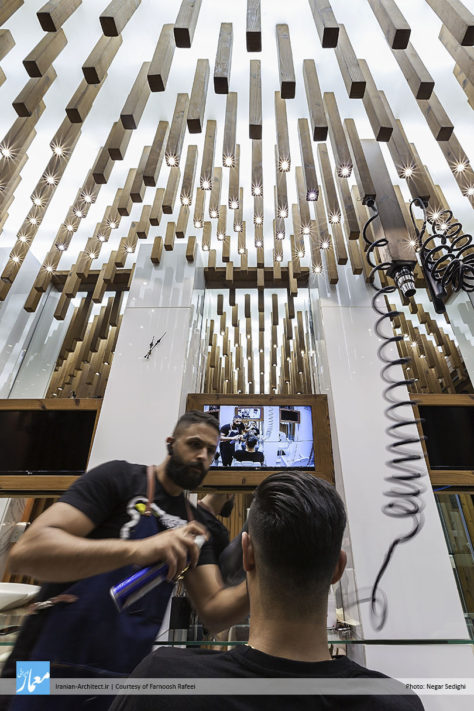
از نظر نورپردازی، استفاده از ورقهای پلکسی در سقف باعث شده است تا نور عمومی پیرایشگاه با حالتی یکنواخت و ملایم همه فضا را روشن کند که در کنار آن، برای کاربری اصلی پیرایش نورهایی متمرکز در بالای محل پیرایش در نظر گرفته شده است. همچنین در راستای کاهش تداخل عملکردها و افراد، دوربینهایی پشت هر صندلی و السیدیهایی مقابل مشتری قرار داده شده است که به وی این امکان را میدهد که در طی فرآیند پیرایش بتواند در هر لحظه پشت سر خود را ببیند. از دیگر مزایای پروژه میتوان به مبلمان انتظار طراحیشده در جداره دیوارها اشاره کرد که موجب گشایش بیشتر فضا میشود و مخاطب را به ماندن بیشتر در محیط دعوت میکند.
Tavalla Barbershop
Farnoosh Rafeei
Location: Isfahan, Iran
Date: 2017
Area: 12.5 sqm
Status: Completed
Client: Mohammad Tavalla
Photo: Negar Sedighi
This project is aimed at the renovation of a barbershop located in Isfahan. Its main attributes are its small dimensions compared to the number of users, in such a way that four people are simultaneously provided with trimming services. The client referred to our office for renovation, in order to overcome the functional problems of the barbershop, and to use the limited space available more efficiently. The project was faced with challenges regarding two scales, interior space and urban space (the street facade), and it had to play a role as a barbershop on both scales.
Regarding interior space, from one point, we had limited space in the shop (2.5 * 5 meters), and from another point, we were faced with the client’s desire of using the maximum amount of available space. Hence, in order to avoid interference of zones and operations that were considered a potential threat to the project, we first referred to the term “hair-cutting”, which means to reduce anything extra and to organize the existing situation. After recognition of the design context and behavioral patterns, we specifically separated each of the functions and tried to shape the architecture of space in each of these sections, in proportion to these functions. In a general look, the zone of the barbershop was divided into two areas: customer (guest) and barber (host). Then, according to the sequence of use of the customer from the area, these areas were divided into smaller parts: waiting, service, preparation and washing. These were then organized to match the users behavior patterns and the behavioral design in the plan.
In terms of form, the hair threads were regarded as the key term to the main subject of hair-cutting, and are used as a pretext, as if it is a rosary connecting all events and functions to each other, in order to make a decent and seamless space. The architectural translation of these hair threads eventually became a soft, wavy-shaped structure of a series of wooden modules (abstract forms of the hair threads on the head) which extended over the ceiling and continued to the wall, and also transformed to decorous lines along the facade.
On a city scale, since the barbershop is located on Mir Street of Isfahan, and is faced with a number of other competitors in this field, the client wanted to make his shop more “more attractive”; So that, he could attract more attention compared to his competitors and also expose part of the skill and events occurring inside to the outside. So, it was attempted that the events regarding skeletal and visual aspects of the inside somehow find way to the outside, and in such a way that the integrity of the space is preserved, the facade is inviting and at the same time appealing to the audience.
Also, in terms of lighting, the use of plexiglass sheets on the ceiling has caused the general lighting of the barbershop to be uniform and moderate all throughout the place. Moreover, focused light above the hair-cutting site is considered for the main purpose of hair-cutting. The technology is regarded as a factor in reducing the interference of operations and people, by placing cameras behind each seat, and LCD s in front of the client, which allows them to see behind their head during the hair-cutting process at all times. Among other benefits of the project, we can mention the furniture used for waiting, which is designed inside the walls. This produces more space and is more inviting to the audience for a longer stay in the place.

